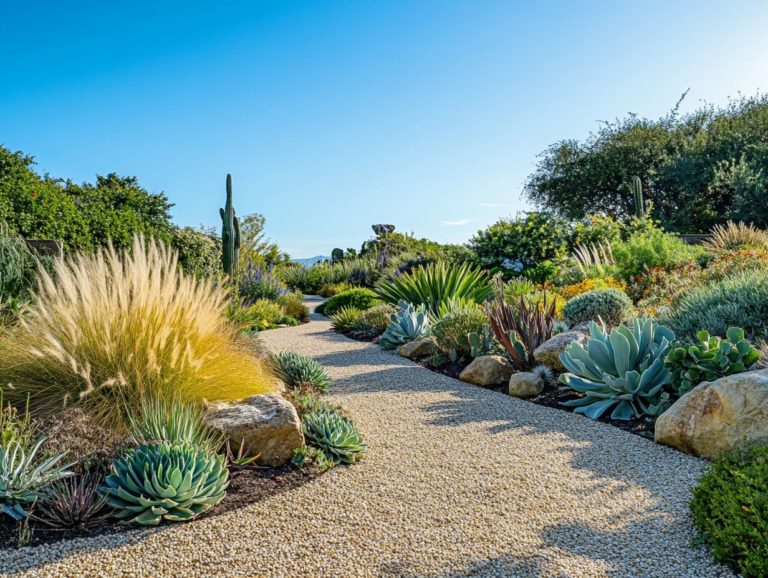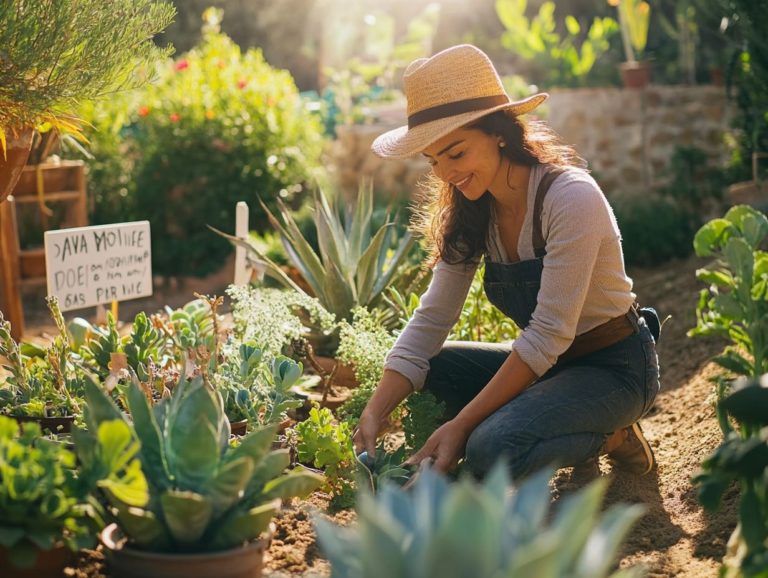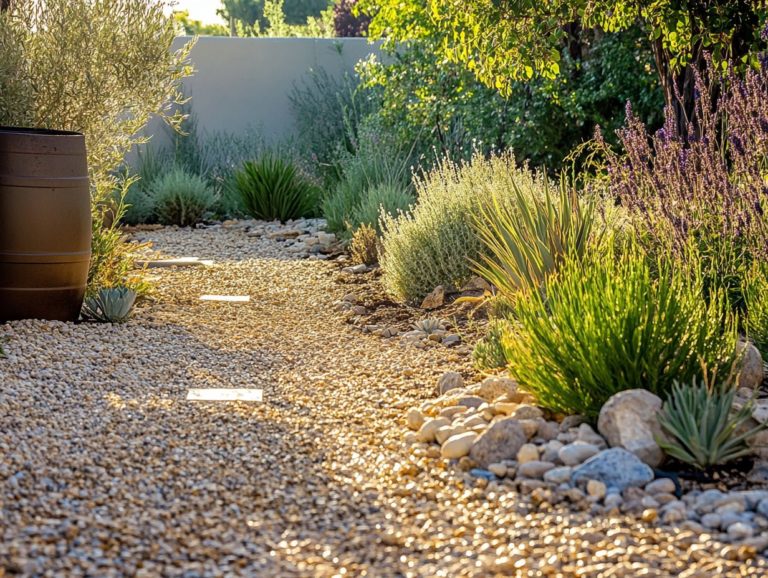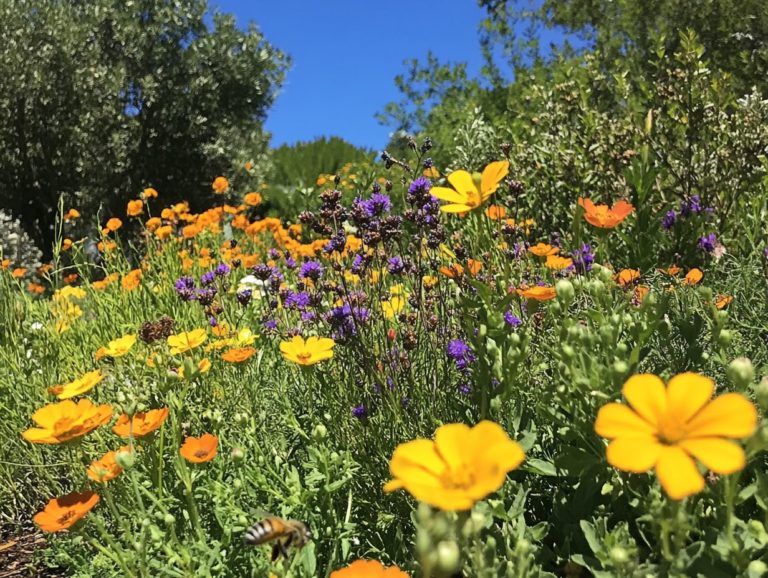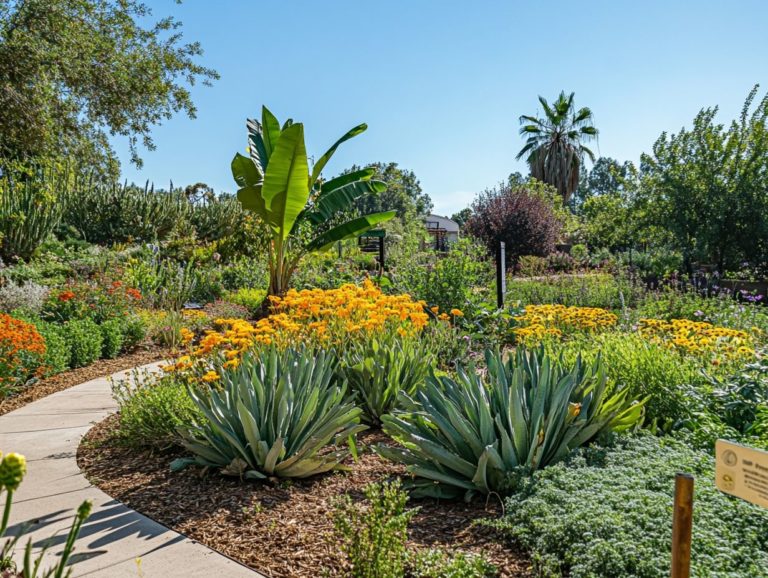Using Native Plants in Drought Gardening
In an era defined by rising drought conditions, your choice of plants in the garden is increasingly vital. Native plants not only flourish in your local climate but also play a significant role in supporting the environment and enhancing biodiversity.
Discover the exciting benefits of using native plants in your drought garden! This article offers insights on selection, design, and maintenance, along with practical tips for conserving water while ensuring your garden thrives during dry spells.
Embrace the beauty and resilience of native flora, and uncover how to cultivate a sustainable outdoor space that benefits both you and the ecosystem.
Contents
- Key Takeaways:
- The Importance of Native Plants in Drought Gardening
- Choosing Native Plants for Your Garden
- Designing a Drought-Resistant Garden with Native Plants
- Maintaining a Native Plant Garden during Drought Conditions
- Other Ways to Conserve Water in Your Garden
- Frequently Asked Questions
- What are native plants such as Palo Verde, Mesquite, Desert Spoon, and Creosote Bush and why are they beneficial for drought gardening in Arizona, where xeriscaping principles are essential?
- What are some examples of native plants that are suitable for drought gardening?
- Do native plants require any special care or maintenance in drought gardening?
- Can I incorporate non-native plants in my drought garden?
- What are the benefits of using native plants in drought gardening?
- What resources are available for learning about native plants in drought gardening?
Key Takeaways:
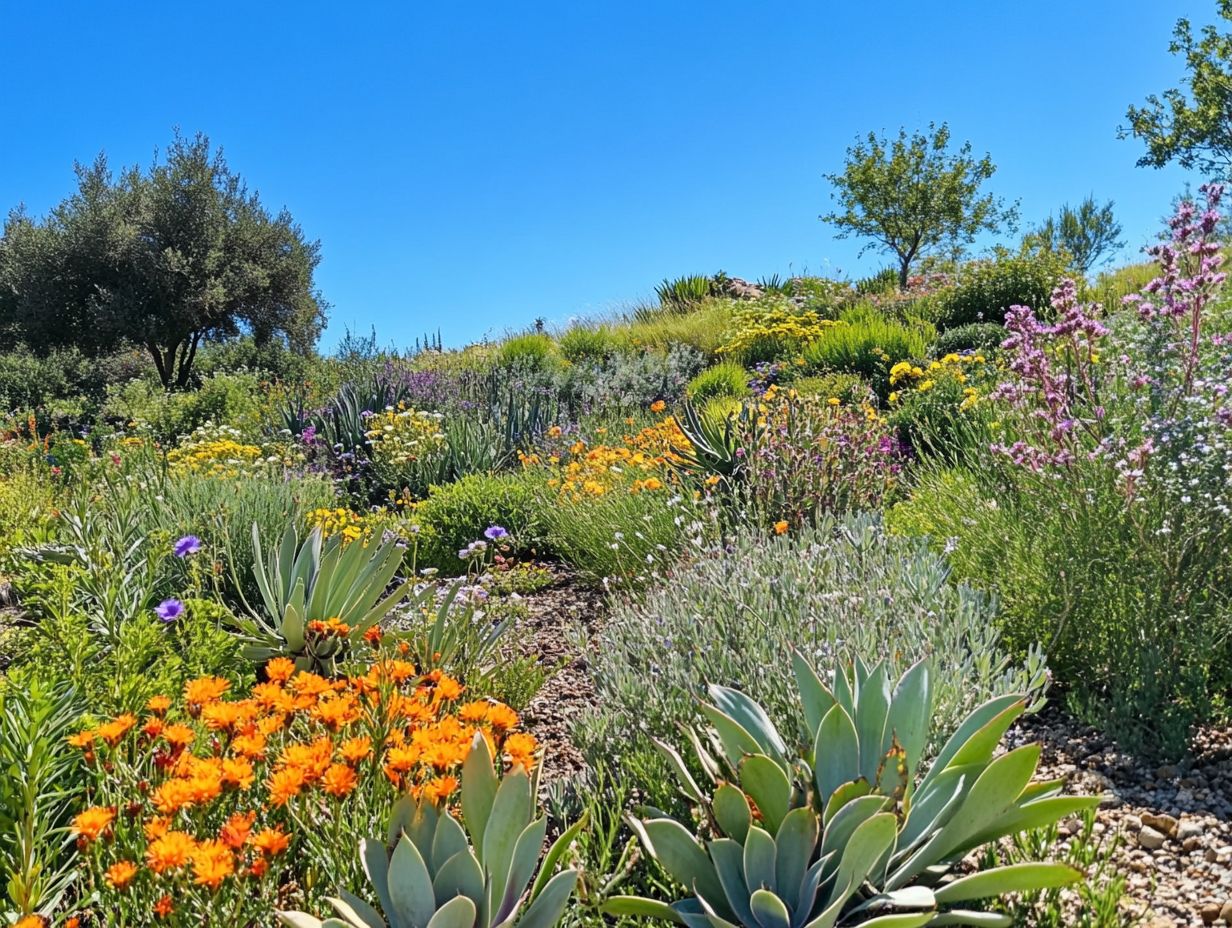
- Native plants need less water and offer many benefits to the environment.
- When choosing native plants, consider factors such as hardiness, soil type, and sun exposure to ensure a successful garden.
- Designing a drought-resistant garden with native plants requires strategies like mulching, grouping plants by water needs, and adding hardscaping elements.
The Importance of Native Plants in Drought Gardening
Incorporating native plants into your drought gardening strategy is essential for crafting resilient landscapes that flourish in arid conditions. By using water-saving gardening techniques for drought, you can create a sustainable garden that saves water and strengthens local ecosystems.
By selecting plants that are well-adapted to your local climate, you can significantly reduce the amount of water plants require while promoting biodiversity and enhancing soil quality. Native plants, equipped with deep root systems and water-storing adaptations, are pivotal in maintaining the health of both your garden and the broader environment.
Benefits for the Environment and Ecosystem
Utilizing native plants in your landscaping brings a wealth of benefits to both the environment and local ecosystems. These plants support many species, enhance water conservation efforts, and improve soil health. Since native plants thrive in local conditions, they require less water and maintenance while providing essential habitats for pollinators and other wildlife.
These plants foster local biodiversity, thrive in harmony with indigenous fauna, and support a robust food web. By choosing plants that are native to your area, you can significantly elevate soil quality, as their deep root systems help prevent erosion and improve nutrient cycling.
This natural balance promotes ecosystem health and attracts crucial pollinators like bees and butterflies, ultimately sustaining agricultural productivity. Integrating native flora into your landscape champions ecological balance and nurtures a sustainable environment that benefits all living organisms.
Choosing Native Plants for Your Garden
Selecting the ideal native plants for your garden demands thoughtful consideration of various factors, including the local climate, soil quality, and the specific requirements of each plant. This approach ensures optimal growth and water efficiency.
By evaluating your garden’s site preparation and understanding the unique traits of native species, you have the opportunity to cultivate a flourishing ecosystem that conserves water and enhances local biodiversity.
Start your native plant garden today by exploring local resources for native plant selections!
Factors to Consider
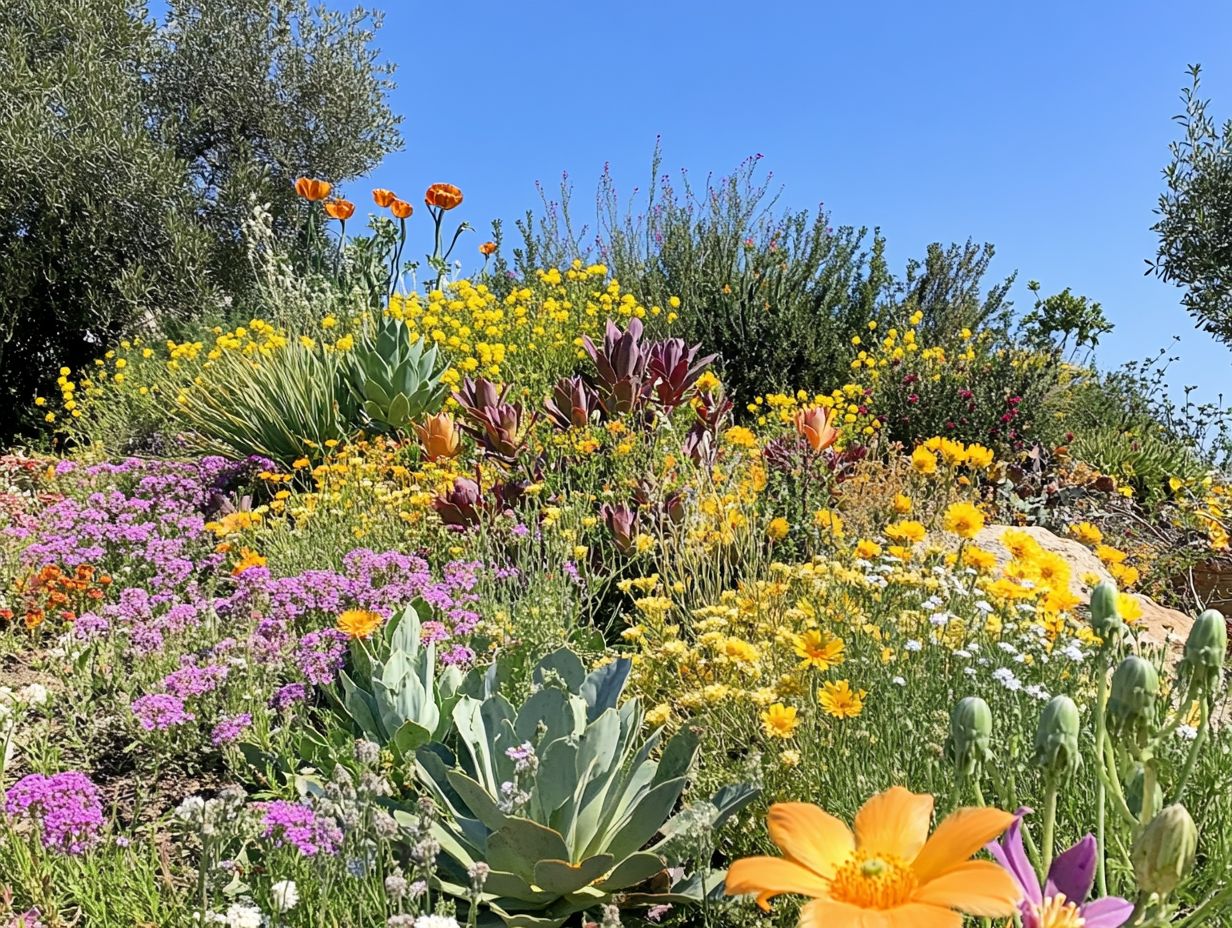
When selecting native plants, it s crucial to consider various factors, including local climate, irrigation needs, soil quality, and potential maintenance costs. Choosing plants that are naturally suited to their environment minimizes resource consumption and enhances the beauty of your landscape.
Understanding the water requirements of specific native species is key to sustainable gardening. Assessing the soil conditions be it sandy, clay, or loamy greatly impacts your plant choices. This approach ensures that your plants flourish while reducing the need for artificial irrigation over time.
Consider long-term maintenance aspects like pruning and pest management to ensure your selections fit your lifestyle and commitment level.
By keeping these factors in mind, you can cultivate vibrant settings that enhance local biodiversity and demand less ongoing effort from you.
Designing a Drought-Resistant Garden with Native Plants
Designing a drought-resistant garden with native plants means creating a beautiful and sustainable landscape that saves water and thrives even in dry conditions. For more information, check out best practices for drought-resistant gardening.
By integrating drought-tolerant landscaping techniques like establishing zones based on varying water requirements and selecting plants with deep root systems you can create a resilient garden that demands minimal irrigation while still captivating the eye.
Strategies and Techniques
Implement effective strategies and techniques, including water-efficient gardening methods and efficient irrigation systems, to significantly enhance water efficiency in your drought-resistant garden. Understanding the challenges of drought gardening is also crucial. Proper site preparation is essential to ensure that native plants thrive, maximizing water conservation while creating an inviting outdoor space.
Start by assessing soil quality and amending it with organic matter to improve water retention. Selecting the right plants, such as succulents and drought-tolerant perennials, helps ensure a vibrant garden that requires minimal irrigation.
Utilizing drip irrigation systems delivers water directly to the roots, reducing waste and promoting healthier plants by preventing excessive moisture loss. Incorporating mulch helps retain soil moisture and minimizes evaporation.
By embracing these integrated approaches, you can cultivate a resilient landscape that conserves water, supports local ecosystems, and enhances the overall aesthetic appeal of your outdoor space.
Maintaining a Native Plant Garden during Drought Conditions
Maintaining a native plant garden during drought conditions requires a thoughtful approach, such as using rain barrels for drought gardening, to ensure the vitality of your plants while minimizing maintenance costs and supporting water conservation initiatives.
Implement effective watering strategies and gain a deeper understanding of your plants’ specific needs to cultivate a flourishing landscape even in challenging environmental circumstances.
Watering and Care Tips
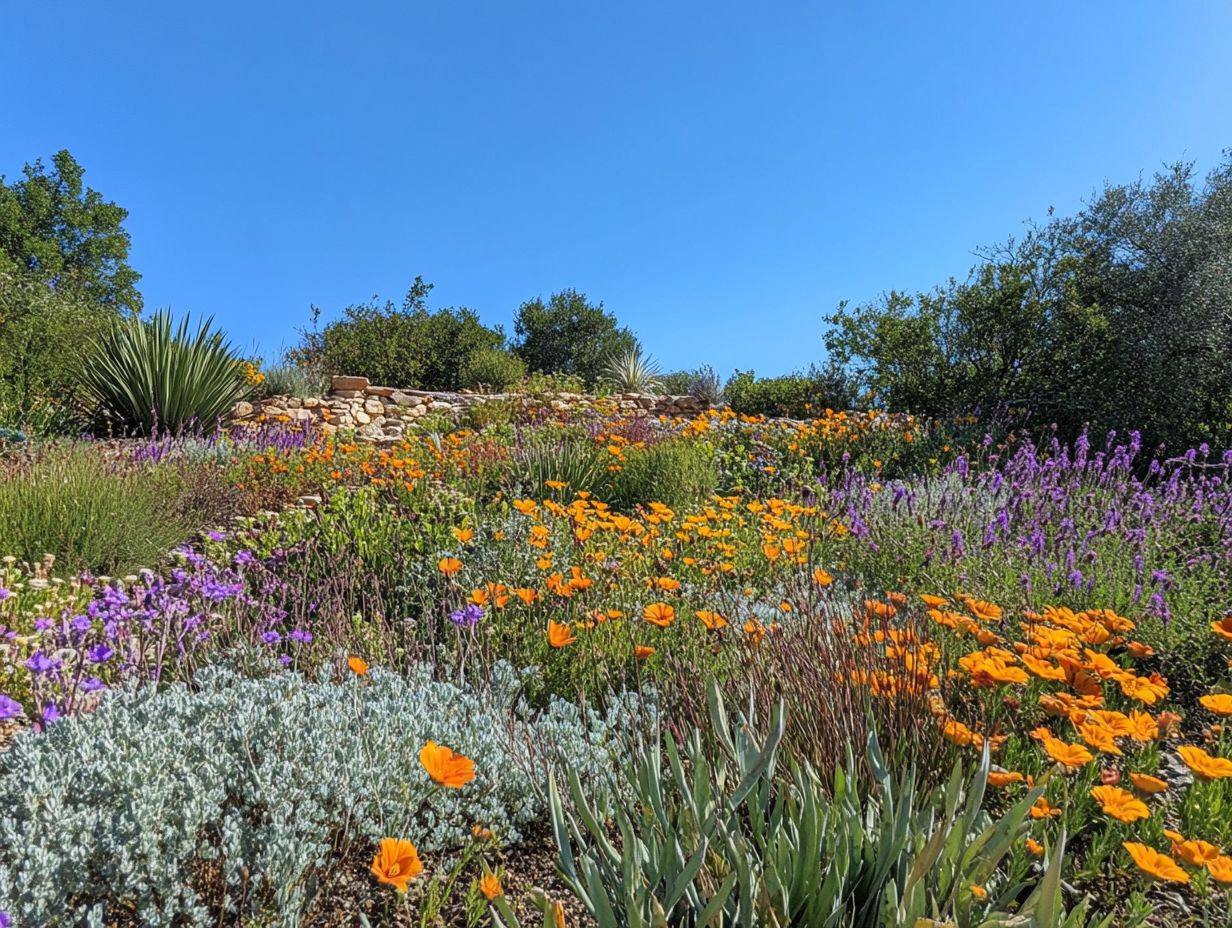
Effective watering and care tips are essential for maintaining plant health in your native garden during drought conditions. To thrive in such environments, it’s important to know the essentials for starting a drought garden. These practices can profoundly influence your irrigation needs and the overall success of your sustainable landscaping efforts. By understanding each plant’s specific requirements, you can optimize water use and foster robust growth.
Timing is crucial; watering early in the morning minimizes evaporation and allows moisture to penetrate the root zone efficiently. Consider utilizing drip irrigation systems, as they deliver water directly to the roots, conserving valuable resources while ensuring your native plants receive essential hydration.
Additionally, mulching around your plants retains soil moisture, regulates temperature, and suppresses weeds, simplifying the maintenance of a flourishing garden. By selecting drought-resistant species and implementing these watering techniques, you can cultivate a resilient landscape that thrives even under challenging conditions, highlighting the significance of sustainable practices for long-term plant health.
Other Ways to Conserve Water in Your Garden
Join the movement to conserve water in your garden! Use these innovative techniques and alternative water sources to elevate your sustainable landscaping practices.
Consider implementing methods like rain gardens and efficient irrigation systems. These not only significantly reduce water usage but also enhance the ecological value and aesthetic charm of your garden.
Embracing these approaches allows you to create a flourishing landscape that thrives on sustainability.
Water-Saving Techniques
Exploring alternative water sources and techniques can elevate your water conservation efforts in the garden while championing sustainable landscaping. By utilizing methods like rain gardens, you can efficiently manage stormwater, providing essential moisture to your plants and cutting down on the need for supplemental irrigation.
These innovative approaches create a self-sustaining garden that encourages biodiversity and nurtures a healthier environment. Rain gardens, meticulously designed to capture excess runoff, not only filter pollutants but also replenish local groundwater supplies.
Adding drip irrigation and greywater systems can further optimize your water usage, ensuring that every precious drop is used wisely. Investing in these methods reduces your dependence on city water and helps with ecological stewardship.
Frequently Asked Questions
What are native plants such as Palo Verde, Mesquite, Desert Spoon, and Creosote Bush and why are they beneficial for drought gardening in Arizona, where xeriscaping principles are essential?
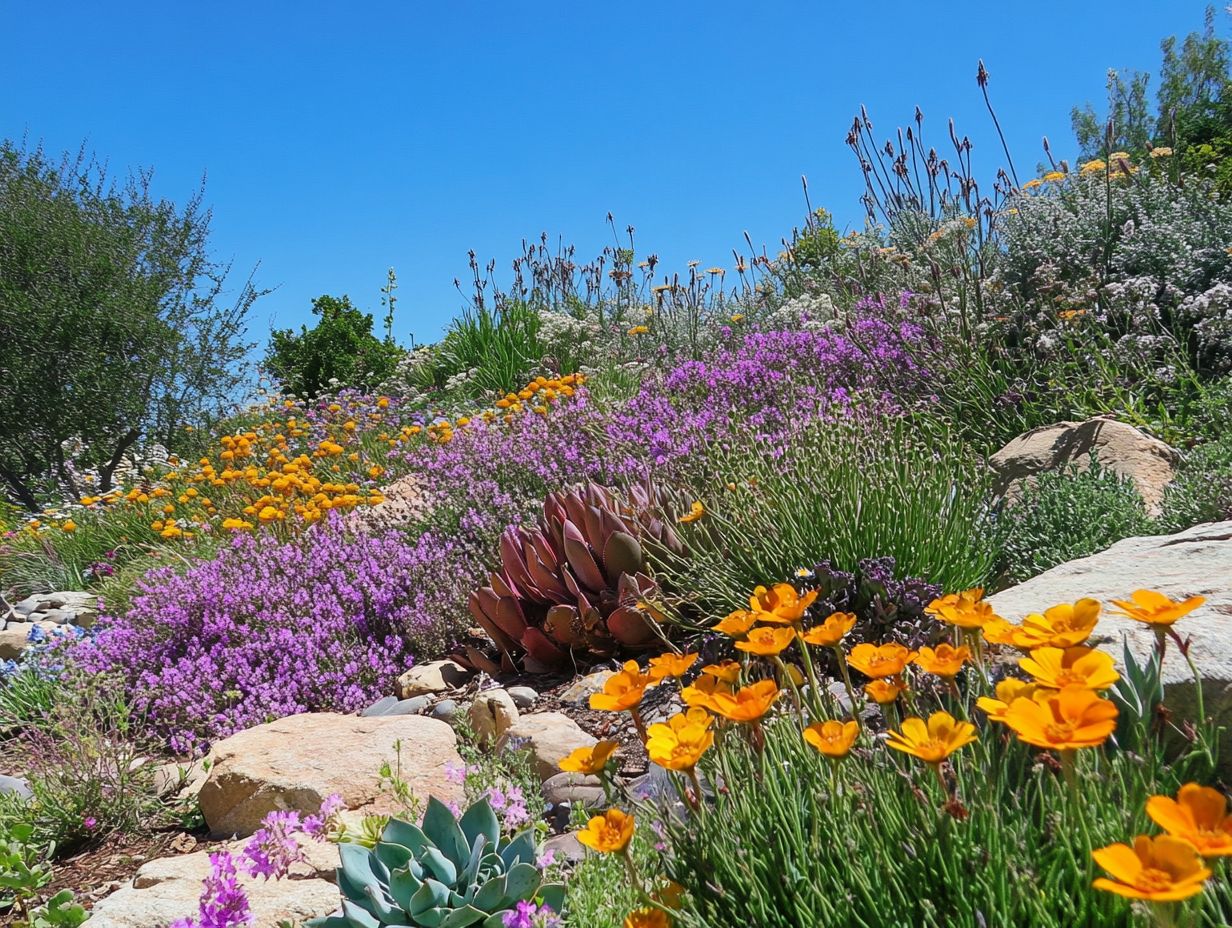
Native plants are those that naturally occur in a particular region without any human influence. They are beneficial for drought gardening because they are adapted to the local climate and are better able to survive with minimal water. They typically require less maintenance and lower costs.
What are some examples of native plants that are suitable for drought gardening?
Some examples of native plants that are suitable for drought gardening include cacti, Buffalograss, and succulents. Other diverse species like Blue Grama Grass, sage, and wildflowers are also excellent choices. To enhance your efforts, check out the best resources for drought gardening to research local climate conditions and determine which specific native plants are suitable for your particular region.
Do native plants require any special care or maintenance in drought gardening?
Generally, native plants require less water and maintenance compared to non-native plants. Xeriscaping principles may also be included in drought gardening, and for more information, you can explore local resources for drought gardening. However, it is important to provide them with well-draining soil and to regularly check for any signs of pests or diseases to ensure plant health.
Can I incorporate non-native plants in my drought garden?
Yes, you can incorporate non-native plants in your drought garden, but it is important to choose ones that are drought-tolerant and not invasive. For more information on this practice, consider learning about companion planting for drought-resistant gardening. It is also recommended to group them together with native plants to create a more diverse and balanced ecosystem.
What are the benefits of using native plants in drought gardening?
Using native plants in drought gardening can help conserve water and attract local wildlife, including pollinators, to your garden. They also promote biodiversity by including both native and non-native species. Understanding the importance of native plants in drought areas highlights that these plants require less maintenance and are more resistant to local pests and diseases.
What resources are available for learning about native plants in drought gardening?
There are many resources available, including books that focus on ways plants store water and efficient irrigation methods. Consulting with experts like Susan Carpenter is valuable for best practices in local ecosystems.
Reach out to local nurseries and gardening experts for tailored advice that fits your region. They can provide you with the best tips to thrive in drought gardening!


